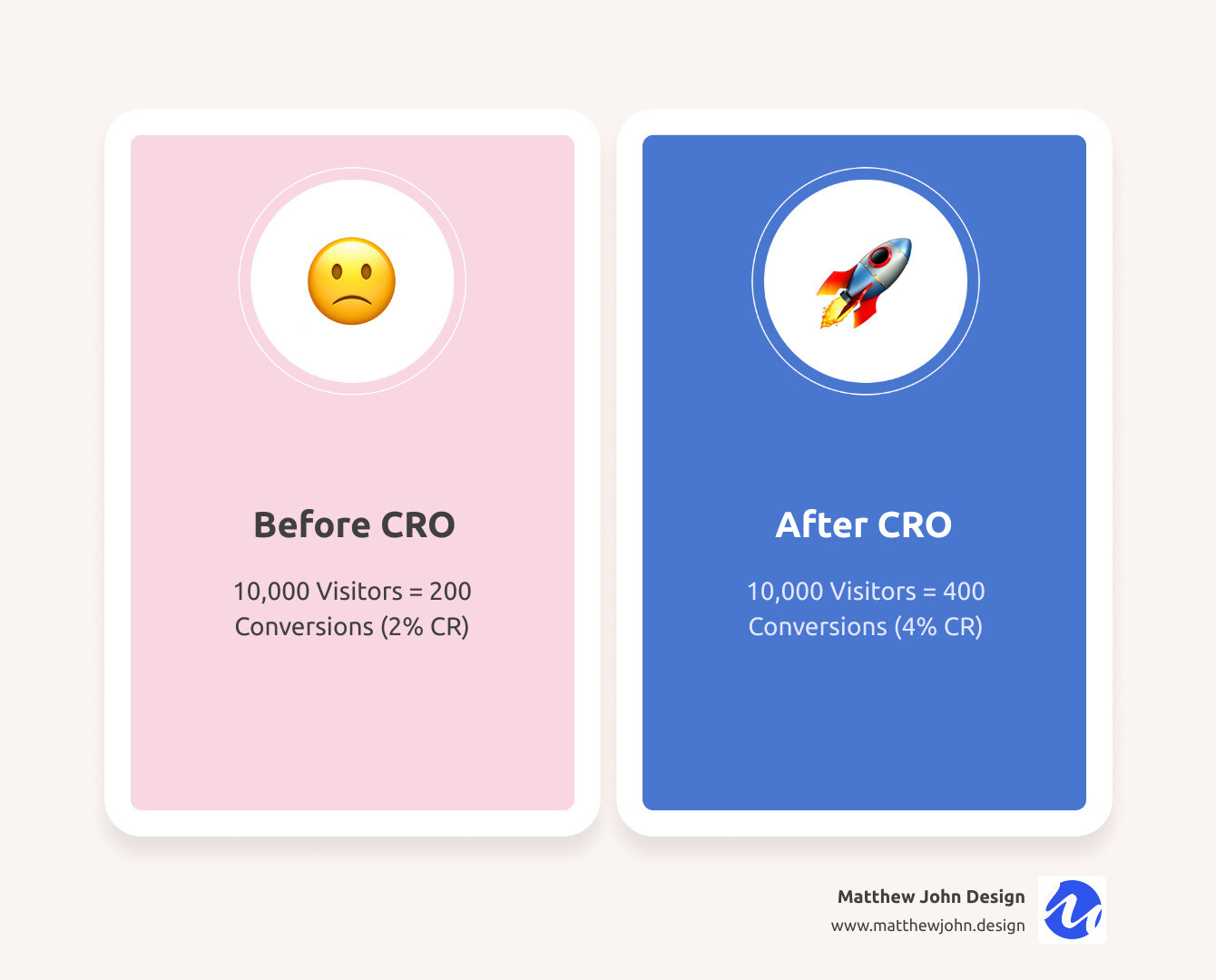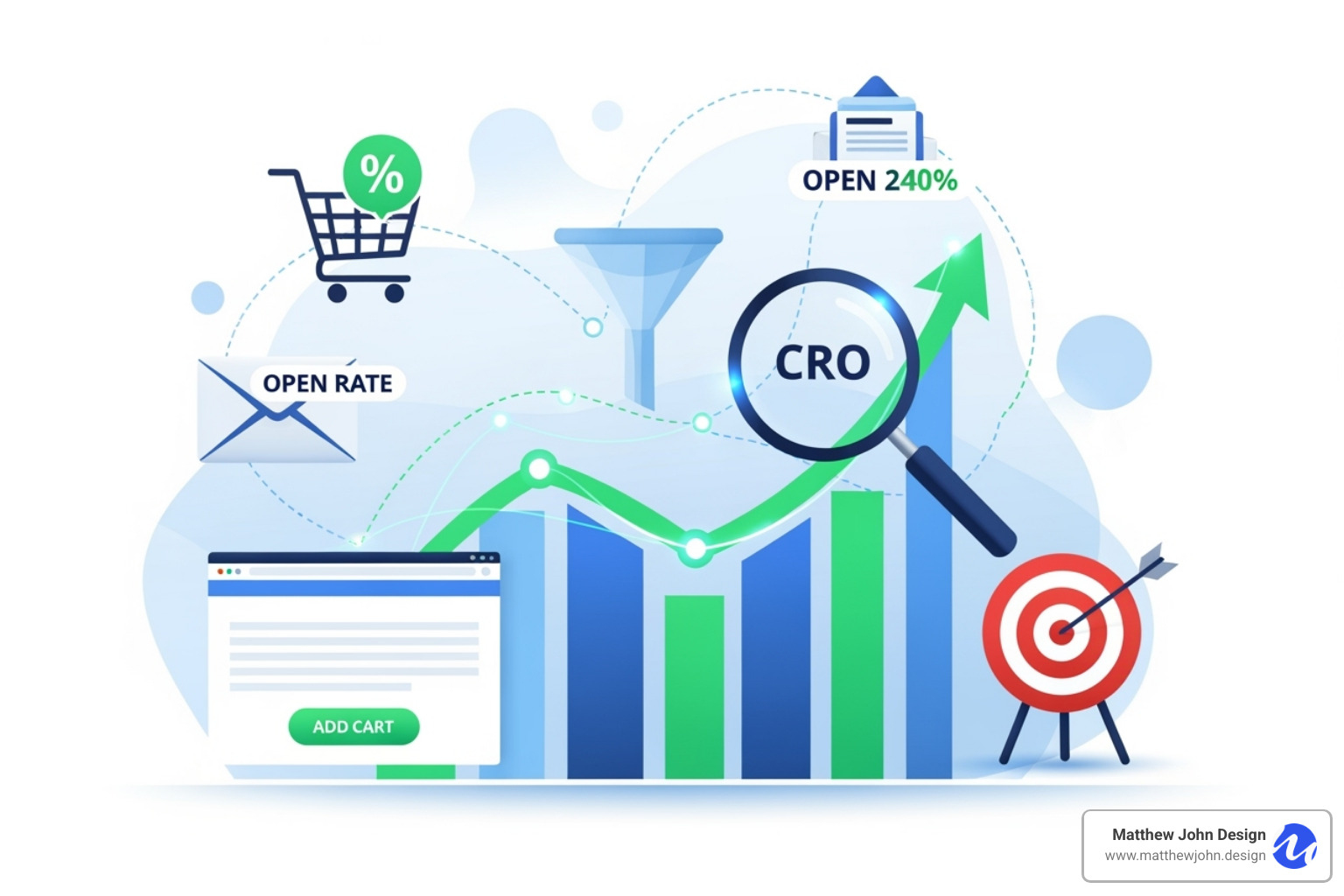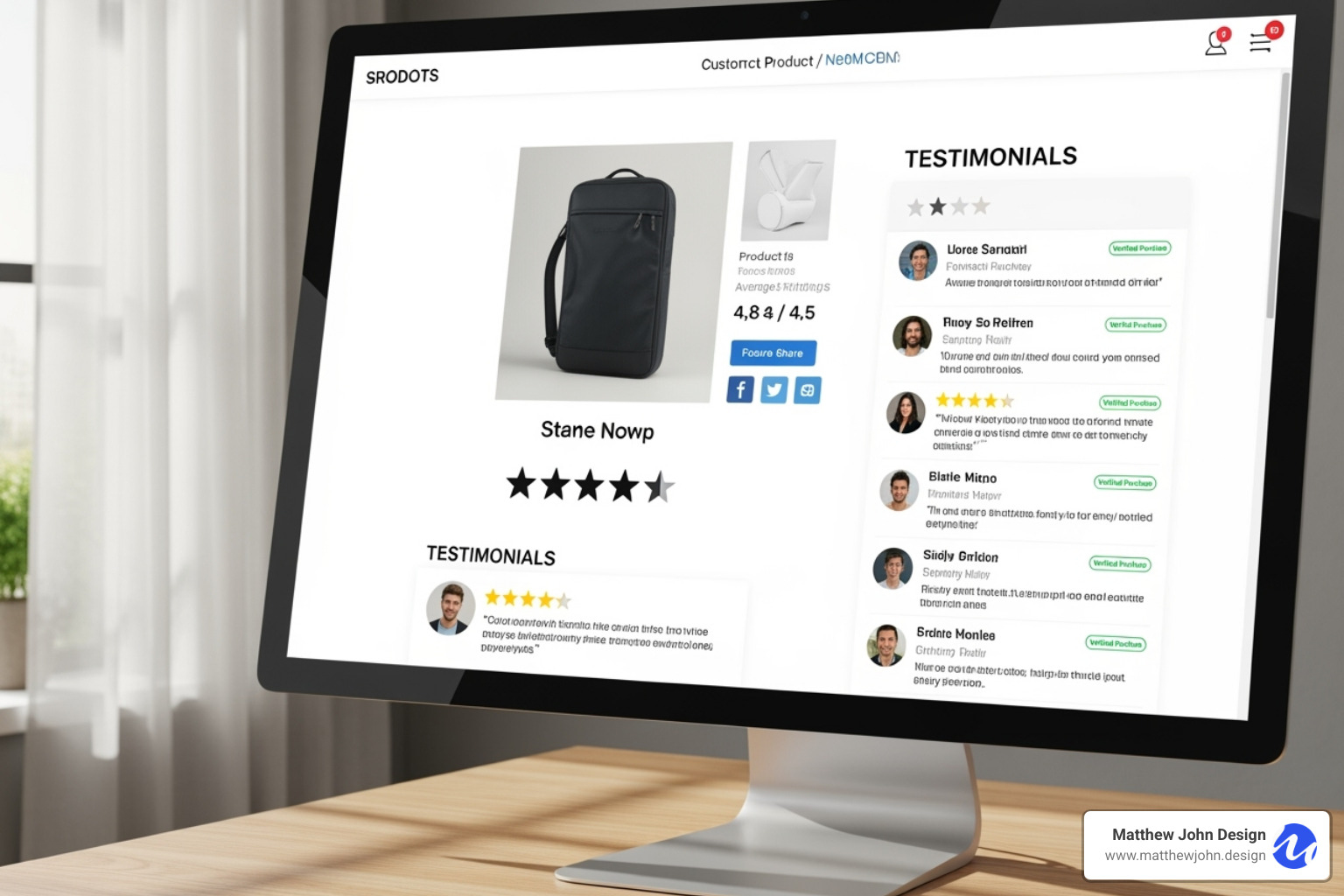Any information contained on this Website is not legal advice and should not be treated as such. You should always contact an attorney for help with your specific legal needs and issues. We may also earn a commission when you click links to our partners and purchase goods or services. For more information, read our Disclaimers Policy.
Beyond Just More Traffic: Understanding CRO's True Value
What is conversion rate optimization in digital marketing? It's the process of increasing the percentage of website visitors who take a desired action, like making a purchase or signing up for a newsletter.
Instead of just pouring more water into a leaky bucket by chasing new traffic, CRO focuses on getting more value from the visitors you already have. It's about fixing the leaks in your sales funnel through:
- Data-driven improvements, not guesswork
- A sharp focus on user experience
- Continuous testing and refinement
Most websites convert only 2.5% to 3% of visitors, meaning small improvements can have a huge impact. For example, if your site gets 10,000 monthly visitors, boosting a 2% conversion rate to 4% doubles your results from 200 to 400 conversions—with the exact same traffic.
CRO isn't about manipulation; it's about understanding your users to remove barriers, creating a better experience for them and delivering measurable results for your business.

What is Conversion Rate Optimization (CRO) and Why Is It Crucial?
At its core, what is conversion rate optimization in digital marketing is about making your website work smarter. It’s the science of turning casual browsers into committed customers by improving the user journey. A "conversion" is any desired action a user takes. These are often split into two types:
- Macro-conversions: These are your primary business goals, like a completed purchase or a free trial sign-up.
- Micro-conversions: These are smaller steps that lead to a macro-conversion, such as adding an item to a cart, subscribing to a newsletter, or downloading a guide.
Optimizing for both types of conversions is crucial. In 2017, 50% of marketers already saw CRO as vital to their strategy, and its importance has only grown. Here's why:
- Improved ROI: CRO maximizes the value of your existing traffic, lowering your customer acquisition cost and increasing revenue. It ensures your marketing budget is spent effectively.
- Improved User Experience: By analyzing user behavior, CRO identifies and removes friction points on your site. This creates a smoother, more enjoyable journey that builds trust and encourages repeat visits.
- Scalable Growth: A high-converting website provides a strong foundation for growth. You can confidently increase traffic, knowing a higher percentage of visitors will become customers.
- Deeper Customer Understanding: The research involved in CRO provides invaluable insights into user motivations and frustrations. This knowledge helps you refine products, services, and marketing messages. For more on this, see Harvard Business Review's take on The value of customer experience quantified.
How is conversion rate calculated?
Calculating your conversion rate is simple. It's the percentage of visitors who completed a desired action out of the total number of visitors.
Conversion Rate = (Number of Conversions / Number of Visitors) x 100
For example, if your website gets 1,000 visitors and 50 make a purchase, your conversion rate is (50 / 1,000) x 100 = 5%. Tools like Google Analytics are essential for tracking these goals automatically.
What is considered a good conversion rate?
There's no single answer to what makes a "good" conversion rate. While averages often float between 1% and 4%, this figure is highly dependent on several factors:
- Industry and Niche: Some industries naturally have higher rates. For example, financial services can average 8.3%, while e-commerce is often closer to 3%.
- Conversion Goal: A free newsletter sign-up will typically have a much higher conversion rate than a high-value purchase.
- Traffic Source: Visitors from organic search often convert better than those from social media ads because their intent is higher.
- Audience Demographics: Different user groups have different buying habits.
While a 2023 survey found an average of 2.9% across 14 industries, the most important metric is your own baseline. A "good" conversion rate is one that is consistently improving over time, proving your optimization efforts are working.
The 4-Step CRO Process: A Framework for Continuous Improvement
Effective what is conversion rate optimization in digital marketing is like tending a garden; it requires a continuous cycle of observation, adjustment, and care. This iterative, data-driven methodology transforms websites from guesswork into conversion machines.

This framework is proven to get results, especially for SaaS companies. You can explore more in our guide: CRO Strategies for SaaS Companies Using Webflow.
Step 1: Research and Data Analysis
Before you change anything, you must understand what's happening on your site and why. This involves two types of data:
- Quantitative Data (The "What"): Using tools like Google Analytics, we analyze user flows, bounce rates, and abandonment points to see where problems occur.
- Qualitative Data (The "Why"): We use heatmaps, session recordings, user surveys, and chat transcripts to understand the user behavior behind the numbers. This phase is foundational to making meaningful improvements, as detailed in the 5 Elements of User Experience.
Step 2: Hypothesis Formulation
Next, we turn research into testable ideas. A strong, data-driven hypothesis avoids random guessing. We use the "If-Then-Because" framework:
If we add prominent free shipping info to product pages, then we'll see a 15% increase in add-to-cart rates, because user surveys showed unclear shipping costs were a major issue.
This structure connects a proposed solution to a specific, identified problem. We then prioritize tests based on potential impact and ease of implementation.
Step 3: Testing and Experimentation
This is where we put our hypotheses to the test. The most common method is A/B testing, where we show half of the visitors the original version (A) and half the new version (B) to see which performs better.

Other methods include multivariate testing (testing multiple elements at once) and split URL testing (testing entirely different page designs). All tests must run until they reach statistical significance (usually a 95% confidence level) to ensure the results are reliable. Research shows only about 12% of experiments produce a clear winner, but every test provides valuable user insights.
Step 4: Analysis and Iteration
After a test concludes, we analyze the results to extract actionable insights.
- Winning variations are implemented permanently, and the learnings are documented to be applied elsewhere.
- Losing variations are just as valuable, as they tell us what doesn't work and why.
- Inconclusive results still help refine our understanding of user behavior.
We segment results by traffic source, device, and user type to gain deeper insights. This knowledge is documented and used to inform the next cycle of testing. This continuous loop of research, hypothesis, testing, and analysis is what turns good websites into great ones.
What is conversion rate optimization in digital marketing's impact on key website elements?
When we discuss what is conversion rate optimization in digital marketing, we're often focusing on specific website elements that directly influence user actions. This includes your website copy, page layout, navigation, and the overall user flow. Optimizing these elements is key to turning visitors into customers.
At Matthew John Design, we build Webflow sites with scalable component-based systems, allowing us to efficiently test and improve these elements. Learn more in our guide: Optimizing Webflow Sites for Higher Conversions: A Guide to CRO.
Optimizing Headlines, Copy, and Social Proof
Your website's copy is its voice. Headlines must grab attention and instantly convey value, while body copy should be clear and address user pain points. Simple text changes can have a massive impact; for example, A/B testing different call-to-action text is a common tactic that can lead to significant conversion lifts.

Social proof builds trust by showing that others have had a positive experience. Key types include:
- Customer testimonials and reviews: Displaying reviews can increase conversions by up to 37%.
- Trust badges and certifications: Security logos and industry awards ease user anxiety.
- Case studies: Detailed success stories are powerful for B2B audiences.
Perfecting Calls-to-Action (CTAs) and Forms
Your Call-to-Action (CTA) is the button that drives conversions. Its design, color, text, and placement are all critical. It must be visible, compelling, and clear. For example, adding icons and trust signals near a CTA is a proven tactic for improving conversions.
Online forms are a common point of friction. To optimize them, we reduce the number of fields to only the essentials, provide clear labels, and use instant validation. As many as 85% of mobile shoppers abandon checkout, often due to complicated forms.
Well-timed pop-ups can also be effective, with an average conversion rate of over 9%. The key is to make them relevant and non-intrusive.
Enhancing Website Performance and Mobile Experience
In today's market, speed and mobile-friendliness are non-negotiable for conversions.
Page load speed has a dramatic impact. It takes only 50 milliseconds for a visitor to form an impression, and a delay of just one second can reduce conversions by 7%. Websites that load in one second convert 2.5 times higher than those that take five seconds. You can test your site's speed with PageSpeed Insights.
With over 58% of web traffic coming from mobile devices, a seamless mobile experience is essential. This means responsive layouts, tappable buttons, and simplified navigation. At Matthew John Design, we build performance-optimized Webflow sites that guarantee a smooth experience on any device.
CRO and SEO: A Powerful Partnership for Growth
Search Engine Optimization (SEO) and what is conversion rate optimization in digital marketing are two sides of the same coin. Think of it this way: SEO gets the right people to your website, and CRO ensures they have a great experience and take action once they arrive.
SEO focuses on visibility in search engines, but traffic alone doesn't guarantee success. CRO is the crucial next step that turns those visitors into customers. Learn more about our approach in our guide: Webflow SEO: 5 Tips.
How CRO benefits your SEO efforts
Google's algorithms reward websites that provide a great user experience (UX). A strong CRO strategy naturally improves key user engagement metrics, which sends positive signals to search engines and can boost your rankings.
- Lower Bounce Rate: When visitors find what they need, they stay longer, signaling relevance to Google.
- Longer Dwell Time: More time spent on your pages indicates engaging, high-quality content.
- Higher Click-Through Rate (CTR): CRO insights can help you write better titles and meta descriptions that earn more clicks in search results.
The research done for CRO also helps you refine your content to better match user needs, which is a win for both users and SEO.
How SEO provides the fuel for your CRO strategy
SEO is essential for CRO because it delivers the right kind of traffic.
- Targeted Traffic: SEO brings visitors who are actively searching for your solutions. These users have higher intent and are more likely to convert.
- Understanding User Intent: Keyword research reveals what users are looking for, allowing you to tailor landing pages to meet their exact expectations.
- Identifying High-Value Pages: SEO analytics pinpoint your most popular pages, which are the perfect candidates for CRO. Improving conversions on these pages can yield significant results.
At Matthew John Design, our SEO services focus on creating engaging content that attracts highly targeted visitors. This provides the perfect, high-quality fuel for your conversion rate optimization efforts.
Frequently Asked Questions about Conversion Rate Optimization
It's common to have questions about what is conversion rate optimization in digital marketing. Let's clear up a few of the most frequent ones.
What is the difference between A/B testing and CRO?
This is a common point of confusion. Think of CRO as the overall strategy for improving your website's performance, and A/B testing as one of the tools you use to execute that strategy.
CRO is the entire process: researching user behavior, forming hypotheses, testing them, and analyzing the results for continuous improvement. A/B testing is a specific tactic within that process used to compare two versions of a page or element to see which one performs better. You can't build a house with just a hammer, and you can't have a full CRO strategy with just A/B testing.
How much traffic do I need to start CRO?
While A/B testing requires significant traffic to achieve statistically reliable results, you don't need a massive audience to begin with conversion rate optimization. If you have lower traffic, you can still gather incredibly valuable insights through other methods:
- Qualitative Feedback: Use on-site surveys and customer interviews to ask users directly about their experience.
- User Testing: Watch a small group of people try to complete tasks on your site to identify obvious friction points.
- Heuristic Analysis: Review your site against established UX best practices to find areas for improvement.
These methods can reveal major opportunities for optimization, regardless of your traffic volume.
How long should I run a CRO test?
The ideal length of a test depends on your site's traffic and conversion rate. The primary goal is to run it long enough to reach statistical confidence—typically 95%—which ensures your results aren't due to random chance.
It's crucial to avoid stopping a test too early, as this can lead to false conclusions. As a best practice, we recommend running tests for at least one full week, and ideally for two full business cycles, to account for daily and weekly variations in user behavior (e.g., weekday vs. weekend traffic).
The true value of CRO isn't just in finding a "winner." Every test, regardless of its outcome, provides valuable learnings that help you understand your users better and inform your next optimization efforts.
Start Optimizing Your Conversions Today
Now that you understand what is conversion rate optimization in digital marketing, the next step is to put these ideas into action. CRO isn't a one-time fix; it's an ongoing journey of continuous improvement, always centered on your users.
Even small, data-backed tweaks can lead to significant wins. We've seen a brand boost conversions by 18% just by adding trust symbols, and another company increased organic conversions by 27% while saving their team 10 hours a week by streamlining their buying process. These are smart, targeted improvements, not massive overhauls.
At Matthew John Design, we believe a great website must be a hard worker. We specialize in creating Webflow sites with scalable component-based systems, empowering your internal team to easily manage and update content. This means your site is not only built for conversions from day one but is also perfectly set up for all your future CRO efforts.
Whether you want to generate more leads, increase sales, or make your website a more effective growth tool, we're here to help. Let's team up to open up your website's full potential.
Get a conversion-focused website with our Website Design and Development Services

